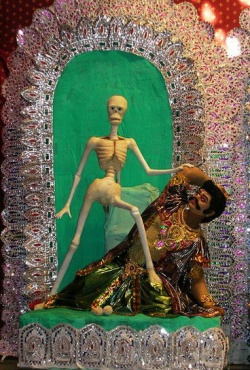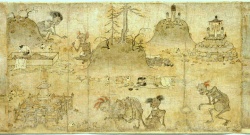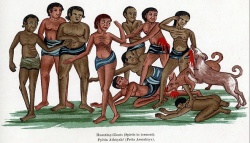Preta
Preta, प्रेत (Sanskrit), Peta (Pāli) or Yidak (ཡི་དྭགས་) in Tibetan is the name for a type of (arguably supernatural) being described in Buddhist, Hindu, Sikh, and Jain texts that undergoes more than human Suffering, particularly an extreme degree of hunger and thirst.
They are often translated into English as "hungry Ghosts", from the Chinese, which in turn is derived from later Indian sources generally followed in Mahayana Buddhism.
In early sources such as the Petavatthu, they are much more varied. The descriptions below apply mainly in this narrower context.
Pretas are believed to have been jealous or greedy people in a previous Life.
As a result of their Karma, they are afflicted with an insatiable hunger for a particular substance or object.
Traditionally, this is something repugnant or humiliating, such as human corpses or feces, though in more recent stories, it can be anything, however bizarre.
Names
The Sanskrit term preta means "departed, deceased, a dead person", from pra-ita, literally "gone forth, departed". In Classical Sanskrit, the term refers to the Spirit of any [[dead [person]], but especially before the obsequial rites are performed, but also more narrowly to a Ghost or Evil being.
The Sanskrit term was taken up in Buddhism to describe one of six possible states of Rebirth.
The Chinese term egui (餓鬼), literally "starving Ghost", is thus not a literal translation of the Sanskrit term.
Description
Pretas are invisible to the human Eye, but some believe they can be discerned by humans in certain Mental states.
They are described as human-like, but with sunken, mummified skin, narrow limbs, enormously distended bellies and long, thin necks.
This appearance is a metaphor for their Mental situation:
they have enormous appetites, signified by their gigantic bellies, but a very limited ability to satisfy those appetites, symbolized by their slender necks.
Pretas are often depicted in Japanese Art (particularly that from the Heian period) as emaciated human beings with bulging stomachs and inhumanly small mouths and throats.
They are frequently shown licking up spilled water in temples or accompanied by demons representing their personal agony. Otherwise they may be shown as balls of smoke or Fire.
Pretas dwell in the waste and desert places of the Earth, and vary in situation according to their past Karma. Some of them can eat a little, but find it very difficult to find Food or drink.
Others can find Food and drink, but find it very difficult to swallow. Others find that the Food they eat seems to burst into flames as they swallow it. Others see something edible or drinkable and Desire it but it withers or dries up before their Eyes. As a result, they are always hungry.
In addition to hunger, Pretas suffer from immoderate heat and cold; they find that even the moon scorches them in the summer, while the sun freezes them in the winter.
The sufferings of the Pretas often resemble those of the dwellers in Hell, and the two types of being are easily confused. The simplest distinction is that beings in Hell are confined to their subterranean World, while Pretas are free to move about.
Relations between Pretas and humans
Pretas are generally seen as little more than nuisances to mortals unless their longing is directed toward something vital, such as blood.
However, in some traditions, Pretas try to prevent others from satisfying their own Desires by means of magic, Illusions, or disguises. They can also turn invisible or change their faces to frighten mortals.
Generally, however, Pretas are seen as beings to be pitied. Thus, in some Buddhist Monasteries, Monks leave Offerings of Food, money, or Flowers to them before meals.
Local traditions
In Japan, preta is translated as gaki (Japanese: 餓鬼, "hungry Ghost"), a borrowing from Chinese e gui (Chinese: 餓鬼, "hungry Ghost").
Since 657, some Japanese Buddhists have observed a special day in mid-August to remember the gaki.
Through such Offerings and remembrances (Segaki), it is believed that the hungry Ghosts may be released from their torment.
In the modern Japanese Language, the word gaki is often used to mean spoiled child, or brat. In a game of tag, the person who is "it" may be known as the gaki.
In Hinduism Pretas are very real beings.
They are a Form, a Body consisting only of air and Akaash (Sky or Black matter or space), two of the five elements which constitutes a Body on Earth or any other planet i.e. Air, Water,Dark Matter (Space), Fire and Earth.
There are other forms as per the ‘Karma’ or ‘actions’ of previous lives where a soul takes birth in bodies resembling human forms or forms of the main intelligent entity in a planet, but with a unique difference that is absence of one to three elements.
In Hinduism an Atma or Soul is bound to take Rebirth after Death in a Body composed of five or more elements.
A soul in transient mode is pure and its existence is comparable to that of a Deva (divine being) but in the last Form of physical birth.
The elements except Akaash or Sky or Black matter as defined is the common constituent throughout The Universe and the Balance four are common to the properties of the planets or stars or places of birth.
This is the reason that Pretas cannot eat or drink as the rest of the three elements (Earth, Fire, and Water) are missing hence no digestion or physical intake is possible for them.
In Thailand Pret (Thai: เปรต) are hungry Ghosts of the Buddhist tradition that have become part of the Thai folklore.
Source
[[Image:Preta_realm.jpg|frame|Depiction of the preta realm from a thangka of the Wheel of Life)]
Preta (Skt.; Tib. ཡི་དྭགས་, yi dak; Wyl. yi dwags) — one of the six classes of beings. Sometimes translated as 'hungry ghost'.
Etymology
The Sanskrit preta literally means 'departed'.
Descriptions
Chökyi Drakpa says:
- "The preta realm is destitute of food and drink, creating hunger and thirst.
It is a grim place of rocks and charred tree stumps, where the words ‘food’, ‘drink’ or ‘comfort’ have never even been heard....
Since these pretas do not find anything to eat or drink for months and years on end, their bodies are emaciated like skeletons and they lack even the strength to stand....
The principal cause [for being reborn there] is being miserly or greedy for wealth and possessions."
Sogyal Rinpoche says in The Tibetan Book of Living and Dying:
- "[In a psychological sense, the hungry ghost realms) exist wherever people, though immensely rich, are never satisfied, craving to take over this company or that one, or endlessly playing out their greed in court cases."
Subdivisions
Patrul Rinpoche speaks of two types of preta: those who live collectively and those who move through space.
The former are further divided into three:
1) those suffering from external obscurations,
2) those suffering from internal obscurations, and 3) those suffering from specific obscurations.
The pretas who move through space, he says, include spirits such as the tsen, gyalpo, shindré, jungpo, mamo, and theurang.
Alternative Translations
- Anguished Spirits (Dorje & Coleman)
- Famished spirit
- Hungry ghost


